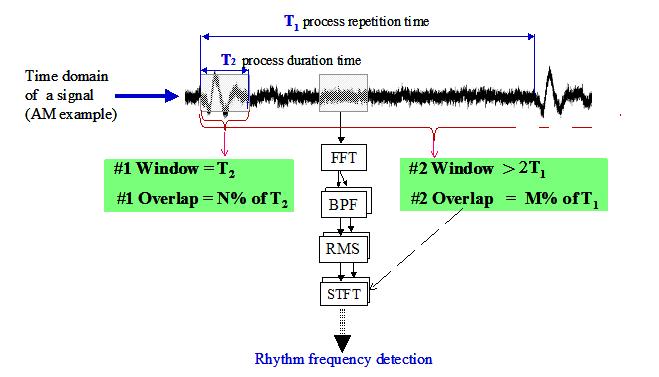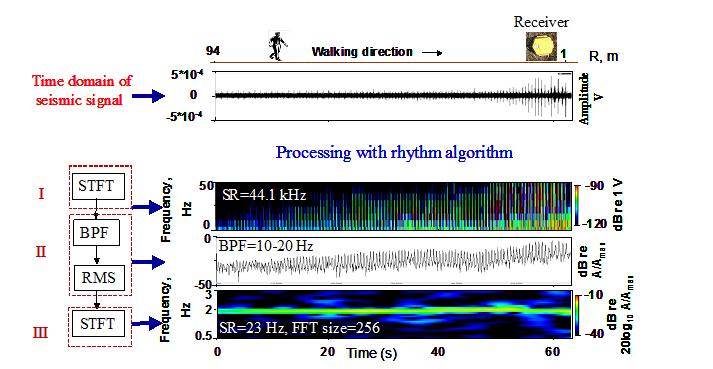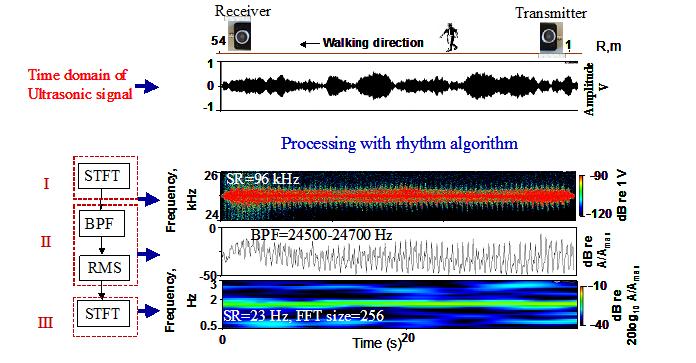
Fig 1. Selection periodic and quasiperiodic sequences in signals.
Alexander Ekimov -- aekimov_99@yahoo.com
1009 Turtle Creek Blvd.
Oxford, MS 38655
Popular version of paper 4aMUa2
Presented Thursday morning, October 25, 2012
164th ASA Meeting, Kansas City, Missouri
Human movements study from walking in different signals (seismic, ultrasonic, and electromagnetic) initiated development signal processing rhythm algorithm, which uses multiple times windows and band pass filters (BPFs) to detect periodic and quasyperiodic sequences in analyzed signals. An application of this algorithm for signals in security systems showed the same values of rhythm (in hertz) for different type (orthogonal) of signals simultaneously measured for the same object – walking people or an animal. A structure of the algorithm is presented in Fig. 1 (Ekimov & Sabatier, 2011, Ekimov, 2011).
 |
Fig 1. Selection periodic and quasiperiodic sequences in signals. |
Where in Fig. 1: AM is the amplitude modulated signal, FFT is the fast Fourier transforms, RMS is root-mean-square, and STFT is the short-time Fourier Transform.
Examples of signals analysis (seismic and ultrasonic) with using small part of the rhythm algorithm (with using two time windows and only one BPF) are presented in Figs. 2, 3. The magnitudes for signals (A) were normalized with respect to the maximum magnitudes (AMAX) and the results for the fundamental rhythm frequencies are presented in dB scale. SR is the sampling rate.
In Fig. 2 a seismic signal of human walking on the straight - line track of 94 m on the ground was analyzed.
 |
Fig 2. Human seismic footstep AM signal analysis (Ekimov, 2011). |
In Fig. 3 the frequency modulated (FM) ultrasonic signal of bistatic 25 kHz Doppler sonar in air for human walking on the straight - line track of 58 m in a building hallway was analyzed.
 |
Fig 3. The analysis of 25 kHz Doppler sonar (bistatic) FM ultrasonic signal from walking human (Ekimov & Hickey, 2012). |
In both of these Figs. 2, 3 the stable rhythms near 2 Hz (solid green lines in figures) were detected. In Fig. 2 the rhythm near 2 Hz corresponds to the human legs motion from footsteps and in Fig. 3 to the human body (torso, legs and arms) motion due to walking.
Application of this rhythm algorithm for a few music sound files also showed presences stable rhythms in the low frequency range (near a few hertz), which were close to the human body footstep motions (Ekimov, 2011). In this article the rhythm analysis of the most known song “Happy birthday” was conducted and results are presented in Figs. 4, 5. The analysis also showed presence stable rhythms, which were close to the human footstep rhythms (solid red line near 2 Hz in Figs. 4, 5).
 |
Fig 4. Rhythm detection in a song “Happy birthday” (Justin Bieber). Sound of musical instruments and a vocal. |
 |
Fig 5. Rhythm detection in a song “Happy birthday” (Anastasia). The vocal only. |
Were rhythms used for human motion synchronizations? This idea was checked on a few military music sound files “British grenadiers” and “The Rifle Regiment” (Figs. 6, 7) and also rhythm analysis founded stable rhythms close to rhythms of the human body footstep motions (red line near 1.5 Hz in Fig. 6 and solid green line near 2 Hz in Fig. 7). Probably in a military music sound the rhythms were used for listeners (solders) motion synchronizations.
 |
| Fig 6. Rhythm detection in military music “British grenadiers”. |
 |
| Fig 7. Rhythm detection in military music “The Rifle Regiment”. |
References:
Ekimov, A., and Sabatier, J. (2011) Rhythm analysis of orthogonal signals from human walking. J. Acoust. Soc. Am., 129, 1306- 1314.
Ekimov, A. (2011) Applications of rhythm algorithm for periodic broadband signals. POMA 14.
Ekimov, A., and Hickey, C. (2012) Ultrasonic bistatic Doppler sonar in air for personnel motion detection. Proc. SPIE 8388, 83880C-1-83880C-6.